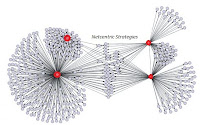
Mobile start-ups often struggle with how to get their message, product and company brand in front of their target markets. They quickly realize that the expense of marketing their solutions directly to each end user is cost prohibitive. How then can they effectively market their solutions in a cost effective manner?
Mobile start-ups need to first identify their target market, and second identify the "market aggregation" points. In the image above, look at the red dots. Those are the market aggregation points. Those are the points where the mobile start-up needs to be marketing. Why? That is where their audience can be found. The eyes and ears of their target market are tuned to that location.
Mobile start-ups should focus all of their efforts and financial resources on the red dot - market aggregation points. Often it costs no more to invest resources in the red dots, than it does to target each end user - end point.
If you are targeting SAP Mobility, then you will want to look for locations that aggregate that market. Where can you find the eyes and ears of the SAP market? If you are focused on field service automation, where is that market aggregated? If your solutions are exclusively for SAP ERP for iPhones, then where is your market aggregated?
Where are the red dot market aggregation points for your market?
If you would like to discuss this topic in more detail please contact me.
***********************************************
Author Kevin Benedict
Independent Mobility Consultant, Wireless Industry Analyst and Marketing Consultant
www.linkedin.com/in/kevinbenedict
twitter: @krbenedict
http://kevinbenedict.ulitzer.com/
http://mobileenterprisestrategies.blogspot.com/
***********************************************
